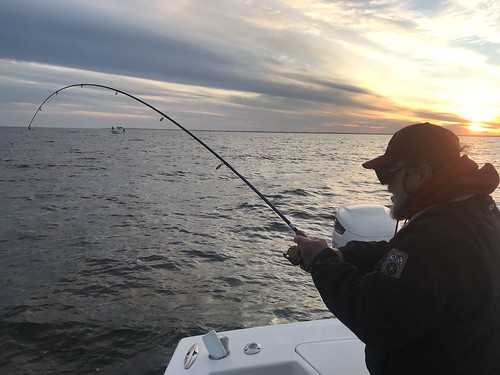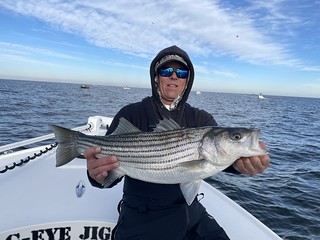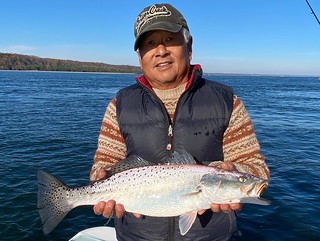Maryland Fishing Report – December 8

As the sun sets on the 2021 striped bass season, this photo sums up the message, “just one more fish, please.” Photo by Travis Long.
This will be our final Maryland Fishing Report for 2021 — look for our midwinter report in January. In the meantime, there are a number of fun adventures anglers and their families can enjoy together the next couple months. All of us at the Maryland Department of Natural Resources wish you peace and happiness over the holidays and in the New Year.
The 2021 Maryland striped bass season comes to a close on Friday, December 10. Anglers in southern Maryland will be able to fish for striped bass in the lower Potomac River until December 31.

If your boat is still in the water or easily launched and you have access to a pair of oyster tongs, you can collect your oysters as Jonathan Irons did with his dad recently. Photo by Mike Irons
Blue catfish provide good and exciting fishing opportunities all winter long. The catfish become more numerous every week as their populations increase and they have spread to inhabit every tidal river in Maryland. They can be found in the deeper channel areas and will take a variety of baits. Blue catfish also make excellent table fare.
Offshore along the Atlantic coast, there are excellent opportunities for black sea bass and tautog. There is a fleet of party and charter boats with warm cabins and all the bait and gear you’ll need for your fishing trip.
Preseason trout stocking in many of the put-and-take trout management waters will start after the holidays and go into February. Once winter sets in, look for safe conditions for ice fishing at Deep Creek Lake and other Western Maryland impoundments. A variety of outdoor and fishing shows are scheduled for 2022 and many anglers are looking forward to attending these shows once again.
For those who have never tried it, collecting your own oysters can be a fun Maryland traditional activity to share with family and friends. If you can keep a watchful eye on tides and can find access to an area where they can be legally collected, fun abounds. Legal collection days are Monday through Saturday from sunrise to noon, and you are allowed 100 oysters per day that measure a minimum of 3 inches. Learn more about recreational oystering in Maryland on the DNR website, which also includes maps of closed areas.
Forecast Summary: December 8 – December 14:
Expect sunny and cool weather on Wednesday and warming the rest of the week, with windy conditions through Sunday. Surface waters and rivers are cooler than the Bay bottom waters. Bay surface water temperatures are holding in the upper 40s. Baitfish have moved out of the rivers in search of the deeper, warmer waters with gamefish nearby. Anglers should focus on the warmer, deeper bottom waters such as river mouths, channel edges, underwater points, hard bottom, and drop-offs from the Bay Bridge south to the Virginia state line.
There is suitable oxygen to the bottom in all of Maryland’s Bay waters. Upper Bay waters down to Tilghman Island are running fresher than normal.
Expect normal flows for most Maryland rivers and streams. There will be above average tidal currents Wednesday and Thursday due to the new moon on Dec. 4.
Expect good water clarity for most of Maryland’s rivers and main Bay areas. To see the latest water clarity conditions, check Eyes on the Bay Satellite Maps.
For more detailed and up-to-date fishing conditions in your area of the Bay, check the Maryland DNR website for Click Before You Cast. Get regular updates on Maryland’s waters sent to your inbox with our Eyes on the Bay newsletter. Sign up online.

Shaun Garrison holds up a whopper of a blue catfish caught in the lower Susquehanna River on a garlic scented night crawler. Photo courtesy of Shaun Garrison
As the striped bass season comes to a close, fishing success at the Conowingo Dam pool and at the mouth of the Susquehanna River have already slowed down once water temperatures dipped into the mid 40s. Casting soft plastics at the dam pool in the early morning hours is the best option available. Most of the striped bass being caught are reported to be under 19 inches, with a longer fish now and then. The same is true near the mouth of the river where jigging along the deeper areas of the channel edges is providing a few fish.
All is not lost for those that wish to continue to fish the area on those sunny and relatively warm days. Although they are unwelcome guests, flathead catfish and blue catfish can provide plenty of action during these colder months. The largest flathead catfish can be found in the dam pool or just below it, and can be caught on cut bait or various live baits. Flathead catfish can easily navigate the stiff currents below the dam.
Blue catfish can be found in the lower Susquehanna, Elk, and Northeast rivers, and the other tidal rivers in the upper Bay. The blue catfish are spread throughout the region and can be found in the deeper waters as surface waters become colder. A variety of cut baits will catch their attention, nightcrawlers, chicken liver, fresh wild shrimp, clam snouts and rangia clams all work well. Fresh cut bait can be tough to find during the winter months, and usually you will have to procure your own.
One avenue open to those who have a recreational crabbing license is catching a few eels for bait. The license allows one to set up to ten eel pots. If you are or know a waterfront landowner or try setting them from a boat, you can catch a few live eels to cut up for bait. Catfish will be waiting in line for such delectable offerings. All eel pots must be marked with your DNR ID number and may not be set in buoy free channels.
A few anglers are finding white perch holding in deep waters in the upper Bay with their depth finders. Dropper rigs of bottom rigs baited with pieces of bloodworm is the best way to target them. Anglers are reporting yellow perch in the middle to upper channels of the tidal rivers and catching them on small minnows, small jigs and beetle spins.
Trolling with heavy inline weights and umbrella rigs is the last-ditch effort to catch a couple of striped bass before the season closes out on Friday, December 10. The striped bass in the upper Bay are hunkered down in the deepest channels and many are not interested in eating due to cold water temperatures. Anglers are never one to give up easily and fish will be caught. The channels near Swan Point, the Triple Buoys, the mouths of the Chester and Magothy rivers, and the Bay Bridge are all good places to cover. Jigging in these same areas is another option for light-tackle anglers. Whichever you choose, your offerings must be down close to the bottom.
Trolling umbrella rigs with heavy inline weights is the most popular way to fish the last days of the 2021 striped bass season. The striped bass are holding deep in the shipping channel, often near the edges in 50 feet to 60 feet of water. The eastern edge of the shipping channel from the Bay Bridge south to Buoy 83 and down to the mouth of the Choptank offers a chance of connection with some striped bass. Anyone trolling this area should keep an eye out now that the commercial gill net season is open. Gill nets are marked with buoys and flags, and the commercial fishermen will be nearby tending those nets in a workboat that is often closed in with canvas or plywood for protection from the cold winds.
There is also some striped bass action on the western side of the shipping channel from Hacketts south past Chesapeake Beach. The same rules apply in regard to the fish hugging the bottom along the 50-foot to 60-foot edges of the channel. These same areas can provide light tackle jigging opportunities when fish can be spotted on depth finders. Large soft plastics in pearl and chartreuse tend to be favorites.
The Calvert Cliffs Power Plant warm water discharge always draws a crowd when the waters of the Bay are cold. Anglers are drifting in the current working soft plastic jigs in hopes of connecting with a few speckled trout that may be nosed into the warm water coming from the discharge pipe. Striped bass will also look for a little relief from the cold on occasion.
Schools of white perch are holding over oyster reefs in the Bay, the mouth of Eastern Bay, the mouth of the Choptank and other tidal rivers within the region. They tend to be in about 30 feet to 50 feet of water and are holding tight to the bottom. A jig with a dropper fly or a bottom rig baited with pieces of bloodworm are the best way to target them.

Travis Long holds up a nice striped bass caught while jigging in the lower Bay. Photo courtesy of Travis Long
The lower Bay offers some of the best striped bass fishing opportunities before the Maryland recreational striped bass season closes Friday, December 10. The Potomac River recreational striped bass fishery will be open until December 31, with a two-fish per day creel limit and a minimum of 20 inches total length. Maryland anglers are advised that only the main stem of the river is open to striped bass fishing until December 31. Tidal rivers on the Maryland side close for recreational striped bass with the rest of the Bay on December 10.
Trolling umbrella rigs weighted down with heavy inline weights is the most popular way anglers are fishing the last few days of the season. The deep edges of the shipping channel in 50 feet to 70 feet of water tend to be where the striped bass are suspended close to the bottom. Most are using bucktails dressed with sassy shads or twistertails for trailers on their umbrella rigs. A fair percentage of the fish being caught are coming up short of Maryland’s required 19 inches, but legal-sized fish are being caught. The west side of the shipping channel from Cove Point south to Point Lookout is a popular location to troll as is the eastern side from Hooper’s Island south to the Middle Grounds. The channels in Tangier Sound are also holding striped bass.
The lower Potomac River has been an excellent place to troll this week along the deeper channel edges. The channel edges in front of the Wicomico River and from Piney Point to St. George Island are good places to troll in the Potomac. The deep channel edges near Buoy 72 and south past buoys 70, 68, 65, and 64 are also great places to troll for striped bass.
Jigging is also an effective way to fish for striped bass, but one must go deep, which can be difficult in wind and current. Watching depth finders for concentrations of fish is essential. Most are using soft plastic jigs, but metal jigs are working well also and tend to be heavier for their size, which is important when lures must be very close to the bottom.

Eric Packard caught and released this brown trout in the Middle Patuxent River on a Panther Martin spinner. Photo by Eric Packard
Western Maryland holds many fishing opportunities through the month of December. At Deep Creek Lake, colder water temperatures have brought walleye from the depths and they can be found in 4 feet to 6 feet of water in the evenings. Casting sinking jerkbaits along rocky shores is a great way to fish for them.
The upper Potomac River is running clear and low and walleye can be found in the deeper holes in the river and behind dams. A variety of small crankbaits, grubs, and minnows are good choices for baits. Smallmouth bass are holding in the deeper holes and current breaks in the river, and suspending jerkbaits, tubes, and hair jigs are good baits to target them.
There are increasing numbers of flathead catfish being found in the upper Potomac and anglers are encouraged to fish for them. A recent electrofishing survey found a threefold increase in the numbers of flathead catfish larger than 16 inches since 2016. Flathead catfish make for excellent eating and can be caught on a variety of live and cut baits.
The trout management areas of the western and central regions will provide plenty of exciting catch-and-release fishing throughout the winter months. Searching for holdover trout from the fall stockings in the put-and-take areas can also be a lot of fun. Casting small spinners, spoons, and tiny jerkbaits are a great way to cover a lot of water when searching for the trout that avoided Powerbait and worm baits.
Largemouth bass are now holding deep along drop-offs and channel edges, and are sticking like glue to any kind of structure they can find. Blade lures in silver or gold color patterns are a popular choice when fishing these deep waters. Slow-rolling spinnerbaits along the bottom is also a good tactic, and hair jigs fitted with soft plastic craws or flukes is another good choice. Just remember the pickups will be subtle and pausing a retrieve is a good way for the fish to catch up.
The winter months and cold water mean the best fishing for chain pickerel in tidal and nontidal waters. These are ambush predators and can be found holding near shoreline sunken wood and fallen treetops. The grass beds are gone so they are looking for any kind of structure they can find. The largest chain pickerel can often be found in deeper water near some cherished structure. Various spinners are candy to chain pickerel and the squirrel-tailed ones are particularly attractive to them. Veteran anglers will usually remove the treble hook and replace it with a single J hook. They also keep long-nosed pliers close at hand for removing hooks from a toothy mouth.
The biologists at the state’s hatcheries have been busy this fall raising and stocking fish for anglers, hatching rainbow trout eggs and raising trout for the 2022 trout season. About 12,000 rainbow trout have been moved to the Manning Hatchery and 3,000 to the Unicorn Hatchery to grow out for the 2022 season. Easing fish densities at the Albert Powell Hatchery helps trout to grow faster and larger.
Antietam Creek received a stocking of 5,000 juvenile brown trout. In Frederick County 5,000 juvenile bluegill and redear sunfish were stocked in Middletown Pond after it was drained and dredged of silt and refurbished. Young largemouth bass were stocked in the Gunpowder River. To provide additional forage base, 25,000 golden shiners were stocked in St. Mary’s Lake, 10,000 in Governor’s Bridge Lake, and 18,000 between Leonard’s Mill Pond and Newtown Park Pond.
Surf casters are a patient bunch and they have been soaking baits in anticipation of migrating striped bass moving along the Maryland beaches. A few striped bass short of the 28-inch minimum are being caught, along with plenty of dogfish and clear-nosed skates.
At the inlet and Route 50 Bridge area, striped bass are being caught by those casting soft plastic jigs and bucktails. Most are sub-legal but a few legal-sized fish are caught now and then. Fishing for tautog at the inlet jetties and the bulkheads and bridge piers inside of the inlet is good this week. Fish under the 16-inch minimum are numerous but there is plenty of action. Pieces of green crab and sand fleas are popular baits.
The best action in the region is the excellent black sea bass fishing at the offshore wreck and reef sites. Boat limits are common every day for all anglers on board. There is also a mix of flounder and triggerfish at times. Tautog fishing at the wreck and reef sites is good and some exceptionally large tautog are being caught. Most of the tautog fishing is being done on charter and party boats that supply green crabs for bait. When weather permits, some charter boats will be making the long run out to the canyons to fish for golden and blueline tilefish.
“A true surf-caster is a man who loves the sea. Far beyond the prize of any great fish he might land is the exhilaration of the wave.” — Negley Farson
Maryland Fishing Report is written and compiled by Keith Lockwood, fisheries biologist with the Maryland Department of Natural Resources.
Click Before You Cast is written by Tidewater Ecosystem Assessment Director Tom Parham.
This report is now available on your Amazon Echo device — just ask Alexa to “open Maryland Fishing Report.”



 1-888-373-7888
1-888-373-7888 233733
233733